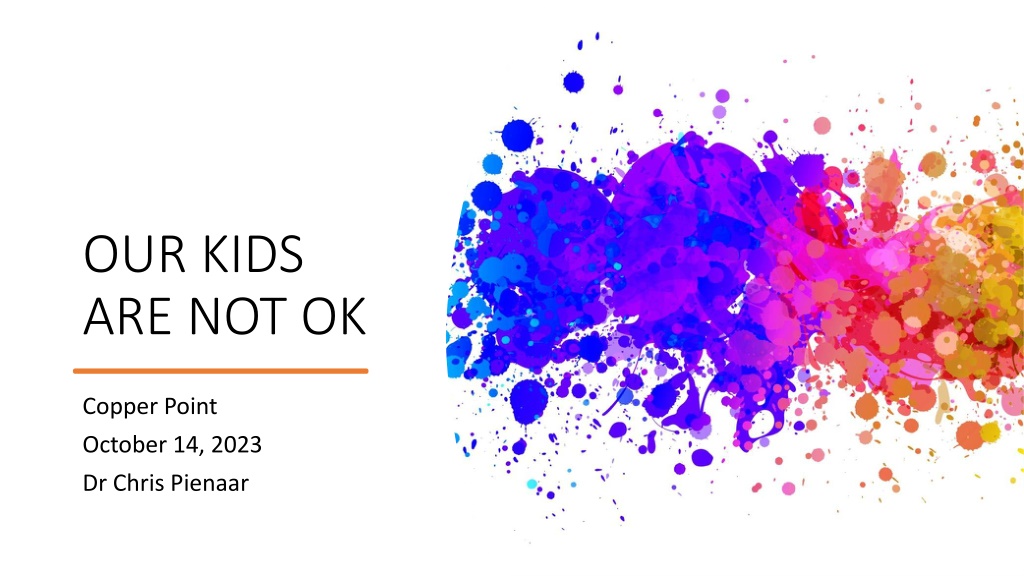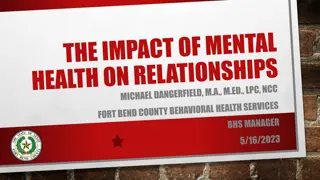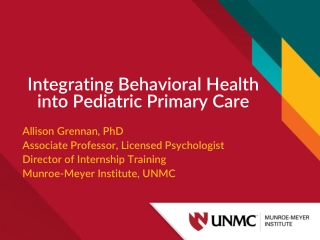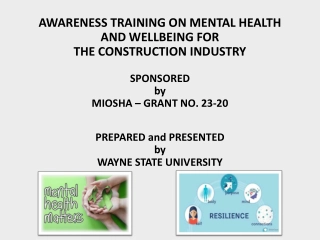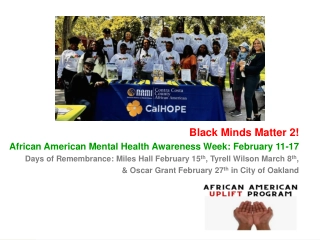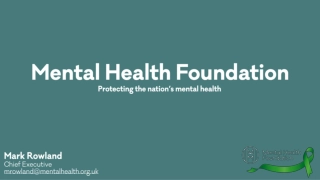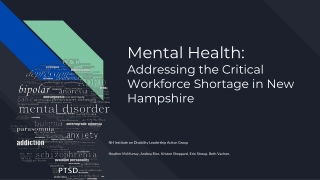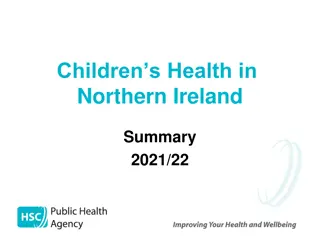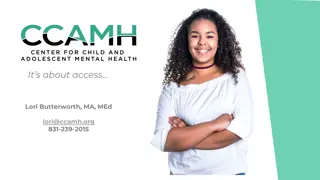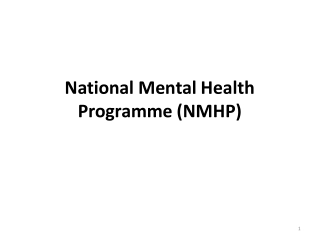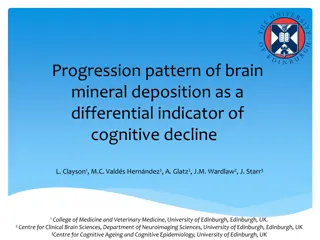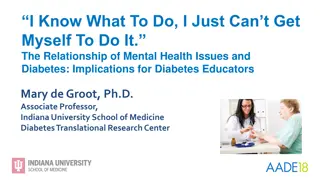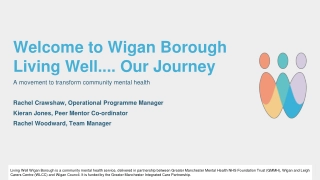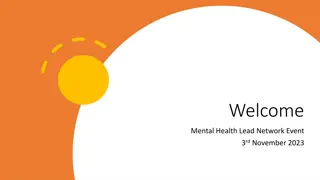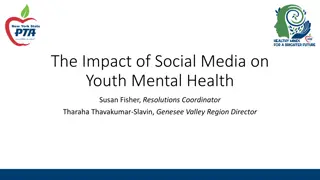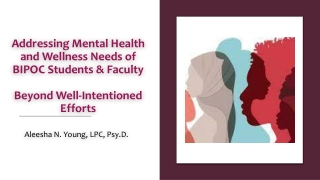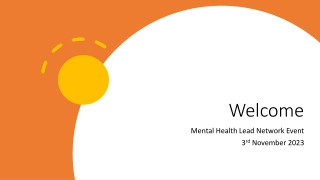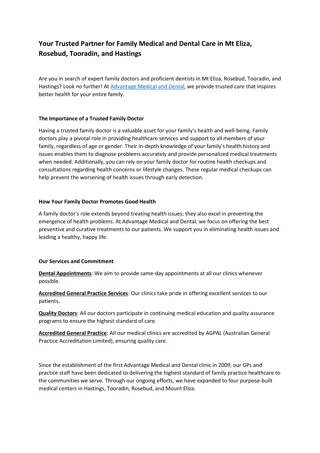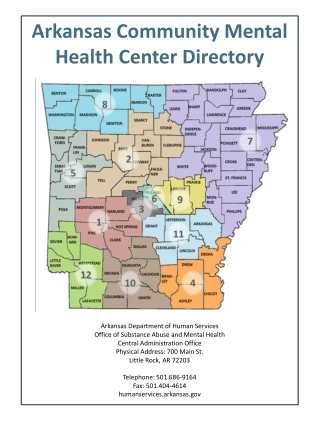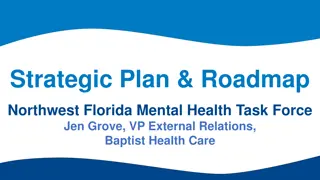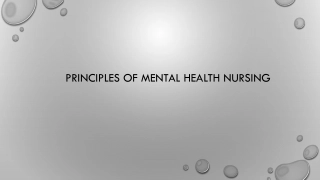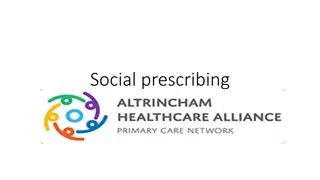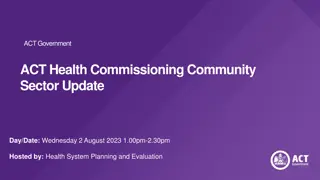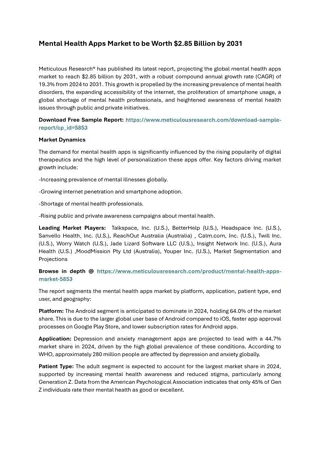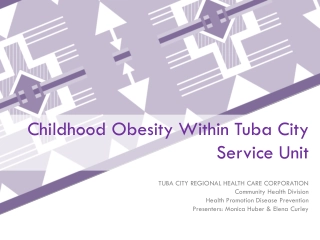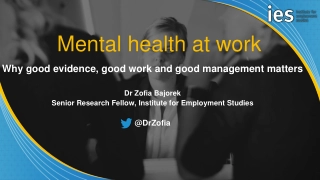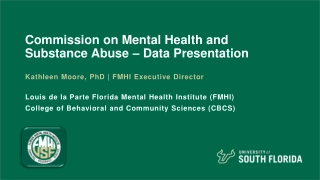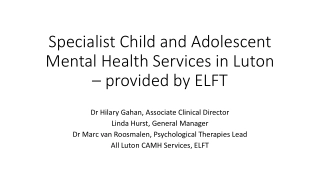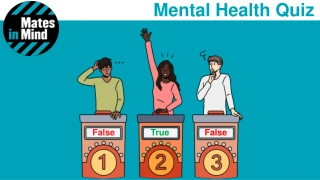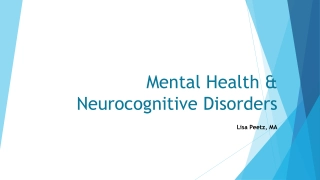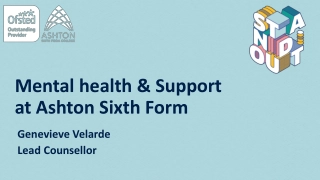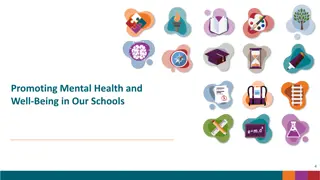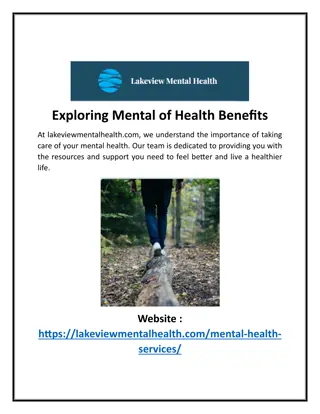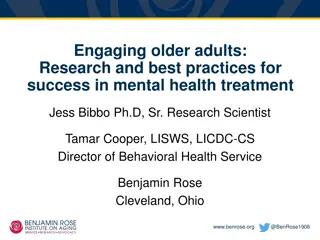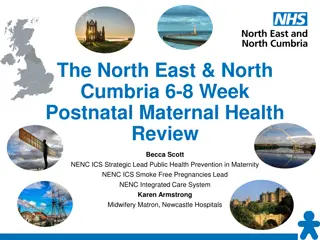Understanding the Decline in Children's Mental Health Trends
Recent studies in Sweden and Ontario show concerning trends in children and adolescents' mental health. The perceived need for professional help has increased significantly, while there has been a decline in conduct disorder cases. Additionally, a study in Ontario reveals a rise in anxiety and depression diagnoses among 5-25 year olds, particularly from ages 11-20. These findings highlight the importance of addressing mental health issues in young individuals.
Understanding the Decline in Children's Mental Health Trends
PowerPoint presentation about 'Understanding the Decline in Children's Mental Health Trends'. This presentation describes the topic on Recent studies in Sweden and Ontario show concerning trends in children and adolescents' mental health. The perceived need for professional help has increased significantly, while there has been a decline in conduct disorder cases. Additionally, a study in Ontario reveals a rise in anxiety and depression diagnoses among 5-25 year olds, particularly from ages 11-20. These findings highlight the importance of addressing mental health issues in young individuals.. Download this presentation absolutely free.
Presentation Transcript
OUR KIDS ARE NOT OK Copper Point October 14, 2023 Dr Chris Pienaar
Learning Objectives 1 2 3 Review current state of mental health of children and youth Promote optimal health outcomes for our children and youth Review management of youth with anxiety and depression including the usage of SSRIs
Disclosures Nothing to disclose May discuss off label usage of medication
Overall the general perception has been that mental health has steadily been declining amongst children and adolescents over the last few decades TRUE???
A population based cross sectional study in Sweden conducted at 2 time points in 1981 and 2014
Examined changes in the prevalence of mental disorders and the perceived need for professional help among children ( aged 4- 11) and youth ( aged 12-16) between 1983 and 2014 in Ontario Similar results saw the perceived need for professional help increased from 6.8% to 18.9% amongst 4-16 year olds Similar to the Swedish study, they also saw a decline in conduct disorder from 7.2% to 2.5% Ontario Child Health Study
Is anxiety/depression increasing among 5-25 year olds? A cross sectional study in Ontario,Canada,1997-2017 (J of Affective Disorders May 2020) This showed the point prevalence of anxiety/depression diagnoses increase with age (girls 2.1 to 16.9%, boys 2.9 to 10.6%, particularly from the ages 11-20
Breakdown of family units and values WHY? WHY? Separation from family supports Many different theories Social Media Pandemic??
An age of An age of Uncertainty Uncertainty The great recession A pandemic with disrupted schooling and social isolation Born in 2006, a young person would have gone through: Cost of living crisis Dealing with climate change
Anxiety about Anxiety about Climate change Climate change Feeling sad Anxious Angry Powerless A survey of 10 000 children across 10 countries, more than 50% responded with: Helpless Guilty
Is Social Media Hurting our Children? Is Social Media Hurting our Children? It is like one big experiment being conducted on our kids ( and us as adults) Limit of safety standards
One experimental study showed that decreasing Social Media ( getting off FB) was equivalent to 1/3 of the value of psychotherapy
Social Media Our children are immersed in a digital world They are growing up with an affected sense of belonging Social Media is ubiquitous and intricately interwoven with the lives of our young people Studies re the relation between social media use and mental health of adolescents are equivocal Some research has shown that problematic social media usage is associated with sleep disturbance, loneliness, depression, conduct behaviour, hyperactivity and sedentary behaviours
Dutch Study ( Child and Adolescent Psychiatry and Mental Health (April 2023) looked at completed suicides of 35 adolescents and prior social media usage The authors concluded that there should be ongoing education to stimulate the digital literacy of parents, health care workers and educators, supporting conscientious social media use in young people and to extend the prevention of cyberbullying
Thought.com A study conducted by the Ecology Centre in Ann Arbor ( healthystuff.org) A 1/3 of the hoses contained organotin, which disrupts the endocrine system. Half of the hoses contained antimony which is linked to liver,kidney and other organ damage. All of the randomly selected hoses contained extremely high levels of phthalates, which can lower intelligence,damage the endocrine system and cause behavioural changes
One Chip Challenge Blue Whale Challenge Global News on MSN 2 hours ago Spicy One Chip Challenge pulled from U.S. shelves after teen dies The extremely spicy 'One Chip Challenge' is a single tortilla chip flavoured with Carolina Reaper and Naga Viper peppers, two of the world's hottest varieties.
Dont focus on the time spend on social media but rather on the content and their experience/understanding of the content = TALK TO YOUR TEEN
Social Connectedness Social Connectedness Relationships and bonds with family and with community, creates a sense of belonging and it provides pathways to opportunities, services and resources The opposite = Social Isolation
Social Connectedness Social Connectedness Kids are growing up looking at the values of the world around them Over the last 5 decades participation in organizations and community has declined
Lack of Human CONNECTION Society is not centered around family anymore We have become a work centered society Humans are however hardwired to CONNECT Kids are not attention- seeking, they are connection-seeking ( Dr Jody Carrington)
To Improve the mental Health of our children we have to support their parents Social connection We need to restore the human, social and financial resources that are essential to being a responsive and nurturing parent
Issue Brief by CPS and Mental Health Commission of Canada 2.Encourage increased collaboration and integration of mental health and developmental service providers for families of children living with physical and developmental disabilities as they are especially vulnerable to the effects of social isolation 3.Expand novel social and community health supports of children from age 6, such as mental health first and peer support programs, ensuring these activities are tailored to broad and divers parent populations 1.Rapidly expand services and support that foster social connection with particular focus on parents who report high levels of social isolation or substance abuse 1 2 3 4.Improve access to green spaces, parks and recreation activities in the community. This is especially critical to reduce the widespread increase in screentime and the decreased physical activity. 5. Ensure funding is available to deliver and sustain services over the long term, given that the effects of prolonged social isolation may persist and emerge over many years 6. Ensure parents can contribute to solutions that respond to their needs 4 5
So What Do We Do? 25% of Canadian Youth will experience mental illness Yet less than 20% of the estimated 1.2million children and youth who are experiencing emotional behavioural and psychological problems serious enough to disrupt function and development, will receive appropriate treatment The majority of mental health disorders in adults starts in childhood and adolescence which makes early identification and timely intervention critical
1. PREVENTATIVE CARE: Each well child visit is an opportunity to discuss parental concerns, to counsel on development and to conduct a mental health surveillance Screen and address social determinants of health ( poor environment, housing, educational inequalities ) Role of the Pediatric Care Provider
2. SCREENING: Implement mental health screening programs ( CPS website/mental-health-screening-tools) Identifies children at risk, assess severity of sx, helps to sort cases into diagnostic categories, helps to monitor treatment progress 3. ASSESSMENT: More focused in depth assessment will identify mental health problems early and help to relieve family stress
4. TREATMENT: Evidenced based treatments such as psycho-therapy, behavioural interventions, pharmacotherapy, educational accommodations and specialized mental health services 5.COLLABORATION: A pediatric mental home with interdisciplinary approach with mental health teams
Management of anxiety and depression in the youth includes many modalities of therapy of which SSRIs are just one Using SSRI`s in Children and Adolescents NOT approved by Health Canada for the treatment of depression in this age group so document clearly USA: FDA approval for fluoxetine in Rx of depression in children and adolescents and escitalopram for Rx of depression in adolescents
Randomized double blind placebo controlled studies and systemic reviews suggest that SSRIs are effective in the treatment of adolescent depression with response rates ranging from 40% to 70% Response rates of patients with placebo are also considerable at 30-60% SSRIs cont. Of all SSRI`s the data are most supportive of fluoxetine Data suggests that only fluoxetine seems effective in children younger than age 12 Paroxetine has shown negative results in 3 RCTs It has also been shown to have the highest rate of withdrawal sx if stopped abruptly
TADS study (Treatment for adolescents with depression) Compared CBT alone, Fluoxetine alone, Placebo and a combination of Fluoxetine with CBT Showed significant greater improvement in depressive sx in medication arms vs placebo/CBT alone
SSRI Side effects Generally well tolerated Short term side effects includes GI sx, sleep changes Sleep disturbances( vivid dreams), restlessness, headaches, appetite changes and sexual dysfunction Mostly dose dependant and decreases over time Increase in activation or impulsivity Rarely risk of bleeding, SIADH, serotonin syndrome Citalopram doses >40mg: risk of QT prolongation and risk of arrhythmia
SSRI`s and suicidality Studies have been looking at increased SI and behaviours NO completed suicides across any of the RCT Recent meta analysis did not find significant risk differences between drug and placebo in the SSRI treatment of depression In the same study was noted that the overall number to harm was 112 ( compared to the NNTT of 10 for SSRIs in depression) thus 10x more children will benefit from SSRIs than would report increase in suicidality)
Research suggests: THE POTENTIAL BENEFIT OF SSRI USAGE OUTWEIGH THE POTENTIAL HARMS FOR THE TREATMENT OF DEPRESSION IN CHILDREN AND ADOLESCENTS UNTREATED DEPRESSION IS MORE LIKELY TO RESULT IN HARM THAN APPROPRIATE USE OF SSRIS CLOSE CLINICAL MONITORING ALONG WITH CAREFUL DOCUMENTATION OF SYMPTOMS AND ADVERSE EFFECTS ARE REQUIRED
Starting an SSRI Start at low starting dose but to aim of reaching the minimum effective dosage over the following 1-2 weeks Should not be allowed to stay on starting doses for prolonged periods of time when having ongoing symptomatic distress FDA recommended that monitoring should take place WEEKLY for the 1st4 weeks, then 2weekly for the next 4 weeks, at 12 weeks, then as clinically indicated after 12 weeks
Monitor for increased suicidality, other than side effects Goal: full remission 4 weekly dose increases Continue for 6 to 12 months Discontinue with a slow taper
SSRI in Depression Summary Fluoxetine has the most data supporting its use in treatment of depression in children and adolescents Citalopram not prescribed in doses > 40mg Citalopram not in individuals with Long QT syndrome, congenital heart disease or a history of arrhythmia Risk of suicidality associated with untreated depression likely greater than the risk associated with SSRI usage
Definite rise in Mental Health Disorders in Children and Youth over the last few years Reasons are ill understood and multifactorial incl. Social breakdown of society and decreased social connectedness SUMMARY Management includes a team approach with community support, counselling and possible usage of SSRIs
CPS: Mentalhealth-screening-tools www.Anxietycanada.com www.KeltyMentalhealth.ca www.Walkalong.ca Mindshift ( App) Strongest Families, Thriving kids Resources:
